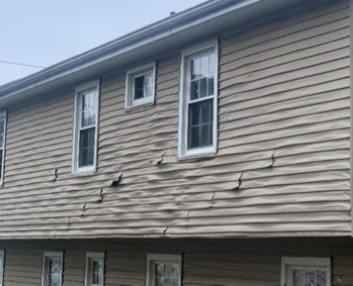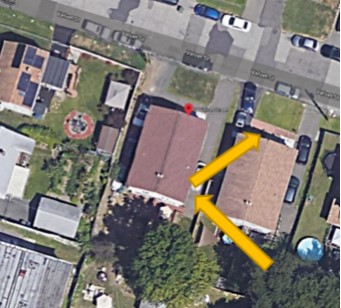What is causing the vinyl siding to MELT, Melt, melt, melt ?
CIE is your Virtual Engineer Onsite
Click here to schedule
| Over the past 10 years I have been asked to examine houses with moderate to severe damage to their vinyl siding. Most of the investigations were simple where it was apparent that the only viable heat source was solar radiation reflection of a neighbor’s windows. We rule out other potential heat sources and then check to see when or if the neighbor replaced their windows. Commonly we find that the neighbor replaced their windows within the last few years. The longer the exposure the greater the deformation. Cissell Investigative Engineering (CIE) can determine the cause and origin of melting vinyl siding. |

Why does this happen?
New windows commonly have low emission coatings (Low-E) that reflect 80-98% of the solar energy. The reflected energy is concentrated on a smaller area of the vinyl siding raising the temperature of the siding. The Vinyl Institute finds that the typical vinyl siding will deform at between 160-165°F. These temperatures have been personally found on siding when checked with an infrared thermometer and a thermal imaging camera. The reflected energy traces an arc across the affected siding as the altitude of the sun changes with the hours of the day. The arc also changes with the season as the azimuth and altitude combine to affect different areas of the siding.

A Unique Problem – One side of a house has vinyl siding that’s 20 years old. The owner noticed that the siding has an unusual deformation of some of the vinyl sections that wasn’t observed two years ago. The deformation is more severe in a small area and there is an arc of damage observable. The neighbor hasn’t changed his windows in the 10 years they owned the home and nothing else changed on the neighbor’s house. What’s causing the deformation?
Findings – The side of the house that is affected faces west. There is a neighbor’s house that is a two story structure located approximately 30’ from the affected side. The neighbor’s house has been there for more than 30 years and no windows have been replaced. The damage is moderate and likely has occurred only over the past two years. A check of Google Earth Pro shows that the affected siding may be exposed to reflected sun off the neighbor’s east side of the house, but there is no new windows installed with Low-E glass. The only change on the neighbor’s property was the installation of solar panels on their garage. The garage has a shallow pitched roof and panels are located on the north and south slopes. Based on the aerial view of the property, the best time to observe the possible conditions is in the afternoon and preferably on a sunny day. Research on the altitude and azimuth of the sun at the location finds the sun angle during the mid-afternoon can potentially reflect off the solar panel.
Examining the site finds that the sun’s solar altitude and azimuth would potentially reflect off the neighbor’s solar panels and onto the siding of the affected structure. The site examination during a sunny afternoon confirms the elevated temperatures on the siding with the only heat source was the reflected solar energy from the neighbor’s solar panels that faced North! Other heat sources were all ruled out by proximity and/or extent of the deformation.
Remedies – If the damage is low enough, landscaping or fencing may be able to shade the affected siding. There are grades of vinyl siding that are more heat resistant and lighter in color; however, I recommend confirming that the siding temperatures from reflected sun is low enough to prevent distortion. A better solution is using a heat resistant siding such as cement board siding or similar products. There are also a couple of ways to reduce the impact from the windows. One way is too have full length screens that will reduce the reflected energy. There are also solar guard films that reduce the reflected energy.
